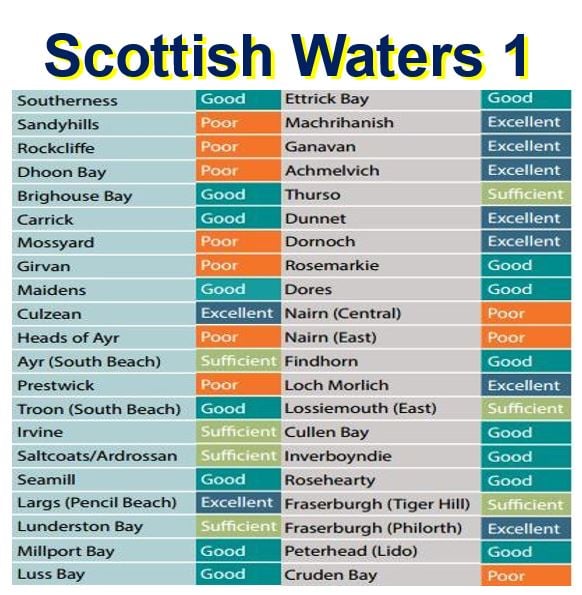A report on Scottish beaches reported that most of them were found to be clean, with seventeen classed as ‘excellent’ following considerably stricter European standards, but 17 were rated as ‘poor’ and failed the minimum EU requirement, says SEPA (Scottish Environment Protection Agency).
A total of eighty-four ‘officially designated bathing waters’ across Scotland were measured by SEPA, which found that 80% of them conformed to the new, much stricter European water quality standards.
 Page 1: Scotland’s 2016 bathing water classifications. Page 2 is below. (Image: SEPA Report)
Page 1: Scotland’s 2016 bathing water classifications. Page 2 is below. (Image: SEPA Report)
– 17 bathing waters have been classed as ‘excellent’,
– 38 have been classed as ‘good,
– 12 have reached a ‘sufficient’ standard.
Room for improvement
However, the stricter water quality standards under the new European classification system, which uses 48 months of monitoring data to provide a more consistent picture of bathing water quality, meant that seventeen of them have been classed ‘poor’.
SEPA’s new classifications will be displayed across beaches in Scotland from May (this month) until the middle of September 2016.
 Page 2: Scotland’s 2016 bathing water classifications. Page 1 is above this image. (Image: SEPA Report)
Page 2: Scotland’s 2016 bathing water classifications. Page 1 is above this image. (Image: SEPA Report)
During the summer, SEPA will be extending its network of electronic signs, which will provide daily real-time water quality data to six new key beach locations – St. Andrews (East and West Sands), Heads of Ayr, Nairn (East and Central) and Fisherrow Sands.
Focus on beaches classed as ‘poor’
Regarding the bathing waters that were given a ‘poor’ rating, SEPA says it is preparing targeted improvement plans to help those beaches meet at least the ‘sufficient’ classification by the end of this decade.
These tailored plans will focus on taking measures to address any problematic pollution sources to improve the use of data and advice on when to avoid going in the water, such as during short periods of greater risk after heavy rainfall and abnormal incidents.
Throughout this process, SEPA will continue working closely with Scottish Water, the Scottish Government, Local Authorities and other key partners, such as local and regional stakeholder groups, as well as the rural and agricultural sectors.
You can read about the EU classification and SEPA’s activities and work on bathing water in its recently-published 2016 Scottish Bathing Waters report.
 One of the several beaches on the Hebrides Islands. Some Scottish beaches are stunning. (Image: gaelholidayhomes.co.uk)
One of the several beaches on the Hebrides Islands. Some Scottish beaches are stunning. (Image: gaelholidayhomes.co.uk)
SEPA’s Environmental Quality Manager, Calum McPhail, said:
“It is encouraging to see that the majority of Scotland’s bathing waters are performing so well under the new Directive which has introduced much stricter standards for bathing water quality.”
“However, we understand that some local communities will be disappointed, as we are, that 17 bathing waters have been rated as having a ‘poor’ EU classification, and many will be concerned when the new classifications are displayed on these beaches for the first time this month.”
“It is important to remember that a ‘poor’ classification does not necessarily mean that water quality is continually poor, and in many cases this is due to historic episodes of reduced water quality following heavy rainfall. These are still fantastic beaches to visit, and our network of electronic information signs provide advice and details about any current water quality issues at the majority of these bathing waters.”
“Scottish bathing waters have been increasing in number and improving in quality since our regulation and monitoring of EU bathing waters began in 1988. We are committed to building on this progress, and to continue to work with the Scottish Government and our key partner organisations to help all bathing waters to avoid ‘poor’ classifications by 2020.”
The new EU Directive places greater emphasis on data provision for bathers and beach users. To help an even greater number of people make informed decisions about whether to use bathing waters, SEPA says it is ramping up its daily water quality predictions to twenty-nine key beach locations this year.
This real-time water quality data can also be obtained via SEPA’s website, a smartphone app and Beachline telephone number.
You can get profiles and information for individual beaches at: apps.sepa.org.uk/bathingwaters/Profiles.aspx
